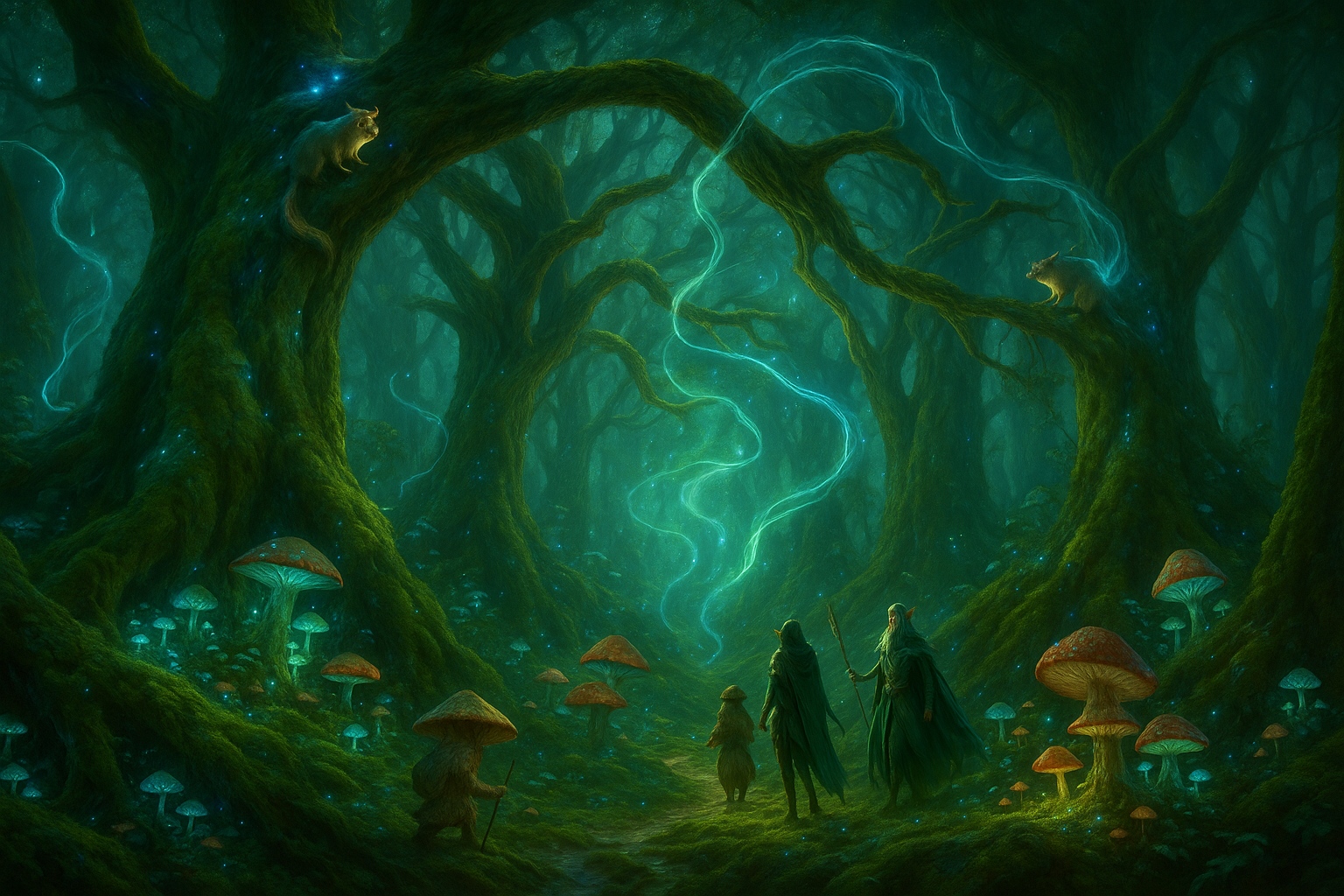Verdant Shiftwood
"The Verdant Shiftwood under Leylight" — concept illustration generated by ChatGPT with DALL·E, based on a design by DMBonnieHodge, 2025.
Nestled in the dense woodlands that form the natural border around the Lilted Vale lies the Verdant Shiftwood, a living labyrinth of ancient trees, sprawling ferns, sentient underbrush, and mercurial ley lines. Unlike typical forests, the Shiftwood is governed by primal wild magic — its landscape subtly and sometimes dramatically rearranges itself, constantly reshaping pathways, clearings, rivers, and even the trees themselves.
It is a place of whispered fey bargains, hidden glades that exist only for a breath, and creatures uniquely adapted to a world that literally does not stay the same from day to day.
Inhabitants & Adaptation
Who lives there?
- Foxfolk trappers and herbalists who follow the subtle signs of the forest’s mood, reading leaf-falls like maps.
- Wandering vinefolk and mushroom folk who move their communities regularly, entwining with whatever new groves grow around them.
- Small enclaves of halflings and gnomes in dwellings designed to be easily dismantled or hidden within shifting roots.
- Tiny fey courts who delight in the change, making ephemeral palaces from blooming canopies that last only a single lunar cycle.
How do they adapt?
- Build homes on broad, walking roots or giant lily pads, designed to migrate naturally with the terrain.
- Employ songspells and charm rituals to politely ask the forest not to move key landmarks.
- Keep guide-spirits — minor elemental companions who sense local ley line surges and warn of coming shifts.
- Celebrate “Finding Days,” joyous local festivals where communities reunite after being separated by the forest’s slow churn.
Geography
The Verdant Shiftwood stretches across a vast basin of gentle hills and shallow vales nestled between the southern arms of the Lilted Vale. While its elevation shifts are subtle, the forest is threaded by countless narrow gullies and fern-choked dells, many harboring temporary streams or mirrored pools that appear overnight.
The forest floor is often carpeted in thick mosses and dotted with clusters of luminous fungi. Slender willow-like trees intermingle with colossal oaks whose roots form natural bridges and hollow shelters. Every so often, massive glades open under wide breaks in the canopy, where wildflowers burst in chaotic brilliance.
Though no great rivers run through it permanently, ephemeral waterways snake through the forest, appearing and vanishing with the whims of the land’s ley tides. Locals whisper of underground springs that rise and sink like breath.
Ecosystem
The Shiftwood hosts a breathtaking tapestry of interdependent life:
- Sporetails — magical possums that feed on glowing fungi, spreading spores while also guarding them from overgrazing by insects.
- Willow drakes, small dragonkin that tend moss gardens in exchange for shelter within massive tree hollows.
- Mycelial tenders, semi-sentient mushroom folk who move fallen branches and leaf litter to feed vast fungal beds, ensuring the balance of decay and renewal.
Predators like shade lynxes and displacer beasts stalk under shifting vines, while flocks of tiny sapphire moths help pollinate night-blooming flowers that only open under moonlight.
Ecosystem Cycles
Unlike most forests, the Shiftwood’s cycle is tied less to conventional seasons and more to the pulse of ley lines beneath it. Roughly every five to seven weeks, the forest undergoes a subtle “pulse,” where root systems swell or contract, drawing moisture in strange patterns.
During traditional autumns, rich orange and crimson hues still appear, but often alongside fresh green shoots — the Shiftwood seems to resist a single seasonal state. Creatures have adapted to be highly nomadic, migrating small distances to follow blooming or fruiting waves that might appear at odd times.
Localized Phenomena
- Ley Surges: Sudden flows of raw magical energy ripple through the soil, causing vines to sprawl meters overnight or flowers to erupt in unexpected fireworks of color.
- Time Ribbons: In certain glades, faint silver currents twist in the air. Passing through them can displace time slightly — travelers might lose or gain minutes, sometimes even hours.
- The Murmuring Bole: A colossal hollow oak rumored to echo voices not yet spoken. Druids believe it listens to the future.
Climate
Generally mild and temperate, bathed in frequent mists that seem almost alive. Rain is common but gentle, feeding mosses and shallow root systems. Strong winds rarely trouble the forest floor — the dense canopy and magical stability of the region dampen storms.
Temperatures hold between cool to comfortably warm, though ley surges can cause abrupt local warm or chill spells for hours at a time.
Fauna & Flora
- Flora:
- Willow giants, twilight oaks, vines that bloom only under starlight.
- Moondrop lilies, nightshade lanterns, and a riot of fungi including luminous cap colonies.
- Fauna:
- Sporetails, displacer beasts, shade lynxes, willow drakes, cloudfire moths, nimble vine frogs that dwell in flower cups.
- Occasional sightings of fey spirits in animal forms, guiding or misleading travelers.
Natural Resources
- Harvested carefully, the Shiftwood offers rare medicinal herbs, spores used in powerful alchemical stabilizers, and wood from fallen trees that resonates with ley energy, prized for crafting druidic staves.
- However, large-scale harvesting is both dangerous and taboo, as it disrupts the delicate magical web and risks angering local fey or mycelial folk.
History
Legends say the Shiftwood was not always so changeable. It became alive with wandering roots and time-touched paths after Fenros, god of the wild, danced his Moon Revel here millennia ago. With every step, he sang new rhythms into the land — forever tying it to the ebb and flow of primal magic.
Throughout Mythralune’s recorded history, the Shiftwood has served as a sanctuary, a mystery, and at times a dire hazard. Druids hold conclaves here, testing initiates to find their way across its mutable groves, while less respectful outsiders occasionally vanish, becoming cautionary tales woven into local ballads.
Remove these ads. Join the Worldbuilders Guild









Comments